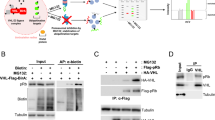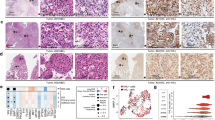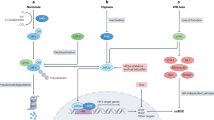Abstract
In clear-cell renal cell carcinoma (ccRCC), inactivation of the tumor suppressor von Hippel–Lindau (VHL) occurs in the majority of the tumors and is causal for the pathogenesis of ccRCC. Recently, a large-scale genomic sequencing study of ccRCC tumors revealed that enzymes that regulate histone H3 lysine 4 trimethylation (H3K4Me3), such as JARID1C/KDM5C/SMCX and MLL2, were mutated in ccRCC tumors, suggesting that H3K4Me3 might have an important role in regulating gene expression and tumorigenesis. In this study we report that in VHL-deficient ccRCC cells, the overall H3K4Me3 levels were significantly lower than that of VHL+/+ counterparts. Furthermore, this was hypoxia-inducible factor (HIF) dependent, as depletion of HIF subunits by small hairpin RNA in VHL-deficient ccRCC cells restored H3K4Me3 levels. In addition, we demonstrated that only loss of JARID1C, not JARID1A or JARID1B, abolished the difference of H3K4Me3 levels between VHL−/− and VHL+/+ cells, and JARID1C displayed HIF-dependent expression pattern. JARID1C in VHL−/− cells was responsible for the suppression of HIF-responsive genes insulin-like growth factor-binding protein 3 (IGFBP3), DNAJC12, COL6A1, growth and differentiation factor 15 (GDF15) and density-enhanced phosphatase 1. Consistent with these findings, the H3K4Me3 levels at the promoters of IGFBP3, DNAJC12, COL6A1 and GDF15 were lower in VHL−/− cells than in VHL+/+ cells, and the differences disappeared after JARID1C depletion. Although HIF2α is an oncogene in ccRCC, some of its targets might have tumor suppressive activity. Consistent with this, knockdown of JARID1C in 786-O VHL−/− ccRCC cells significantly enhanced tumor growth in a xenograft model, suggesting that JARID1C is tumor suppressive and its mutations are tumor promoting in ccRCC. Thus, VHL inactivation decreases H3K4Me3 levels through JARID1C, which alters gene expression and suppresses tumor growth.
This is a preview of subscription content, access via your institution
Access options
Subscribe to this journal
Receive 50 print issues and online access
$259.00 per year
only $5.18 per issue
Buy this article
- Purchase on SpringerLink
- Instant access to full article PDF
Prices may be subject to local taxes which are calculated during checkout






Similar content being viewed by others
References
Arany Z, Huang LE, Eckner R, Bhattacharya S, Jiang C, Goldberg MA et al. (1996). An essential role for p300/CBP in the cellular response to hypoxia. Proc Natl Acad Sci USA 93: 12969–12973.
Barski A, Cuddapah S, Cui K, Roh TY, Schones DE, Wang Z et al. (2007). High-resolution profiling of histone methylations in the human genome. Cell 129: 823–837.
Berrios M, Osheroff N, Fisher PA . (1985). In situ localization of DNA topoisomerase II, a major polypeptide component of the Drosophila nuclear matrix fraction. Proc Natl Acad Sci USA 82: 4142–4146.
Beyer S, Kristensen MM, Jensen KS, Johansen JV, Staller P . (2008). The histone demethylases JMJD1A and JMJD2B are transcriptional targets of hypoxia-inducible factor HIF. J Biol Chem 283: 36542–36552.
Cheung I, Shulha HP, Jiang Y, Matevossian A, Wang J, Weng ZP et al. (2010). Developmental regulation and individual differences of neuronal H3K4me3 epigenomes in the prefrontal cortex. Proc Natl Acad Sci USA 107: 8824–8829.
Dalgliesh GL, Furge K, Greenman C, Chen LN, Bignell G, Butler A et al. (2010). Systematic sequencing of renal carcinoma reveals inactivation of histone modifying genes. Nature 463: 360–363.
Ema M, Hirota K, Mimura J, Abe H, Yodoi J, Sogawa K et al. (1999). Molecular mechanisms of transcription activation by HLF and HIF1alpha in response to hypoxia: their stabilization and redox signal-induced interaction with CBP/p300. EMBO J 18: 1905–1914.
Epstein AC, Gleadle JM, McNeill LA, Hewitson KS, O'Rourke J, Mole DR et al. (2001). C. elegans EGL-9 and mammalian homologs define a family of dioxygenases that regulate HIF by prolyl hydroxylation. Cell 107: 43–54.
Huang TT, Wuerzberger-Davis SM, Wu ZH, Miyamoto S . (2003). Sequential modification of NEMO/IKKgamma by SUMO-1 and ubiquitin mediates NF-kappaB activation by genotoxic stress. Cell 115: 565–576.
Iliopoulos O, Kibel A, Gray S, Kaelin Jr WG . (1995). Tumour suppression by the human von Hippel-Lindau gene product. Nat Med 1: 822–826.
Isaacs JS, Jung YJ, Neckers L . (2004). Aryl hydrocarbon nuclear translocator (ARNT) promotes oxygen-independent stabilization of hypoxia-inducible factor-1 alpha by modulating an Hsp90-dependent regulatory pathway. J Biol Chem 279: 16128–16135.
Ivan M, Haberberger T, Gervasi DC, Michelson KS, Gunzler V, Kondo K et al. (2002). Biochemical purification and pharmacological inhibition of a mammalian prolyl hydroxylase acting on hypoxia-inducible factor. Proc Natl Acad Sci USA 99: 13459–13464.
Ivan M, Kondo K, Yang H, Kim W, Valiando J, Ohh M et al. (2001). HIFalpha targeted for VHL-mediated destruction by proline hydroxylation: implications for O2 sensing. Science 292: 464–468.
Iwase S, Lan F, Bayliss P, de la Torre-Ubieta L, Huarte M, Qi HH et al. (2007). The X-linked mental retardation gene SMCX/JARID1C defines a family of histone H3 lysine 4 demethylases. Cell 128: 1077–1088.
Jaakkola P, Mole DR, Tian YM, Wilson MI, Gielbert J, Gaskell SJ et al. (2001). Targeting of HIF-alpha to the von Hippel-Lindau ubiquitylation complex by O2-regulated prolyl hydroxylation. Science 292: 468–472.
Kaelin Jr WG . (2002). Molecular basis of the VHL hereditary cancer syndrome. Nat Rev Cancer 2: 673–682.
Kamura T, Koepp DM, Conrad MN, Skowyra D, Moreland RJ, Iliopoulos O et al. (1999). Rbx1, a component of the VHL tumor suppressor complex and SCF ubiquitin ligase. Science 284: 657–661.
Klose RJ, Yan Q, Tothova Z, Yamane K, Erdjument-Bromage H, Tempst P et al. (2007). The retinoblastoma binding protein RBP2 is an H3K4 demethylase. Cell 128: 889–900.
Kondo K, Kim WY, Lechpammer M, Kaelin Jr WG . (2003). Inhibition of HIF2alpha is sufficient to suppress pVHL-defective tumor growth. PLoS Biol 1: E83.
Kondo K, Klco J, Nakamura E, Lechpammer M, Kaelin Jr WG . (2002). Inhibition of HIF is necessary for tumor suppression by the von Hippel-Lindau protein. Cancer Cell 1: 237–246.
Krieg AJ, Rankin EB, Chan D, Razorenova O, Fernandez S, Giaccia AJ . (2010). Regulation of the histone demethylase JMJD1A by hypoxia-inducible factor 1 alpha enhances hypoxic gene expression and tumor growth. Mol Cell Biol 30: 344–353.
Li N, Carrel L . (2008). Escape from X chromosome inactivation is an intrinsic property of the Jarid1c locus. Proc Natl Acad Sci USA 105: 17055–17060.
Linehan WM, Vasselli J, Srinivasan R, Walther MM, Merino M, Choyke P et al. (2004). Genetic basis of cancer of the kidney: disease-specific approaches to therapy. Clin Cancer Res 10: 6282S–6289S.
Maxwell PH, Wiesener MS, Chang GW, Clifford SC, Vaux EC, Cockman ME et al. (1999). The tumour suppressor protein VHL targets hypoxia-inducible factors for oxygen-dependent proteolysis. Nature 399: 271–275.
Mersman DP, Du HN, Fingerman IM, South PF, Briggs SD . (2009). Polyubiquitination of the demethylase Jhd2 controls histone methylation and gene expression. Genes Dev 23: 951–962.
Mikhaylova O, Ignacak ML, Barankiewicz TJ, Harbaugh SV, Yi Y, Maxwell PH et al. (2008). The von Hippel-Lindau tumor suppressor protein and Egl-9-Type proline hydroxylases regulate the large subunit of RNA polymerase II in response to oxidative stress. Mol Cell Biol 28: 2701–2717.
Nakamura E, Abreu-e-Lima P, Awakura Y, Inoue T, Kamoto T, Ogawa O et al. (2006). Clusterin is a secreted marker for a hypoxia-inducible factor-independent function of the von Hippel-Lindau tumor suppressor protein. Am J Pathol 168: 574–584.
Negrotto S, Hu ZB, Alcazar O, Ng KP, Triozzi P, Lindner D et al. (2011). Noncytotoxic differentiation treatment of renal cell cancer. Cancer Res 71: 1431–1441.
Ohh M, Park CW, Ivan M, Hoffman MA, Kim TY, Huang LE et al. (2000). Ubiquitination of hypoxia-inducible factor requires direct binding to the beta-domain of the von Hippel-Lindau protein. Nat Cell Biol 2: 423–427.
Pollard PJ, Loenarz C, Mole DR, McDonough MA, Gleadle JM, Schofield CJ et al. (2008). Regulation of Jumonji-domain-containing histone demethylases by hypoxia-inducible factor (HIF)-1alpha. Biochem J 416: 387–394.
Rini BI, Sosman JA, Motzer RJ . (2005). Therapy targeted at vascular endothelial growth factor in metastatic renal cell carcinoma: biology, clinical results and future development. BJU Int 96: 286–290.
Roesch A, Fukunaga-Kalabis M, Schmidt EC, Zabierowski SE, Brafford PA, Vultur A et al. (2010). A temporarily distinct subpopulation of slow-cycling melanoma cells is required for continuous tumor growth. Cell 141: 583–594.
Schraml P, Frew IJ, Thoma CR, Boysen G, Struckmann K, Krek W et al. (2009). Sporadic clear cell renal cell carcinoma but not the papillary type is characterized by severely reduced frequency of primary cilia. Mod Pathol 22: 31–36.
Semenza GL . (2003). Targeting HIF-1 for cancer therapy. Nat Rev Cancer 3: 721–732.
Semenza GL . (2007). Hypoxia-inducible factor 1 (HIF-1) pathway. Sci STKE 2007: cm8.
Semenza GL, Agani F, Booth G, Forsythe J, Iyer N, Jiang BH et al. (1997). Structural and functional analysis of hypoxia-inducible factor 1. Kidney Int 51: 553–555.
Sharma SV, Lee DY, Li BH, Quinlan MP, Takahashi F, Maheswaran S et al. (2010). A chromatin-mediated reversible drug-tolerant state in cancer cell subpopulations. Cell 141: 69–80.
Tahiliani M, Mei P, Fang R, Leonor T, Rutenberg M, Shimizu F et al. (2007). The histone H3K4 demethylase SMCX links REST target genes to X-linked mental retardation. Nature 447: 601–605.
Thoma CR, Toso A, Gutbrodt KL, Reggi SP, Frew IJ, Schraml P et al. (2009). VHL loss causes spindle misorientation and chromosome instability. Nat Cell Biol 11: 994–1001.
Wellmann S, Bettkober M, Zelmer A, Seeger K, Faigle M, Eltzschig HK et al. (2008). Hypoxia upregulates the histone demethylase JMJD1A via HIF-1. Biochem Biophys Res Commun 372: 892–897.
Xia X, Lemieux ME, Li W, Carroll JS, Brown M, Liu XS et al. (2009). Integrative analysis of HIF binding and transactivation reveals its role in maintaining histone methylation homeostasis. Proc Natl Acad Sci USA 106: 4260–4265.
Yan Q, Bartz S, Mao M, Li L, Kaelin Jr WG . (2007). The hypoxia-inducible factor 2alpha N-terminal and C-terminal transactivation domains cooperate to promote renal tumorigenesis in vivo. Mol Cell Biol 27: 2092–2102.
Yang H, Minamishima YA, Yan Q, Schlisio S, Ebert BL, Zhang X et al. (2007). pVHL acts as an adaptor to promote the inhibitory phosphorylation of the NF-kappaB agonist Card9 by CK2. Mol Cell 28: 15–27.
Zhang HF, Gao P, Fukuda R, Kumar G, Krishnamachary B, Zeller KI et al. (2007). HIF-1 inhibits mitochondrial biogenesis and cellular respiration in VHL-deficient renal cell carcinoma by repression of C-MYC activity. Cancer Cell 11: 407–420.
Zhou X, Sun H, Chen HB, Zavadil J, Kluz T, Arita A et al. (2010). Hypoxia induces trimethylated H3 lysine 4 by inhibition of JARID1A demethylase. Cancer Res 70: 4214–4221.
Zimmer M, Doucette D, Siddiqui N, Iliopoulos O . (2004). Inhibition of hypoxia-inducible factor is sufficient for growth suppression of VHL−/− tumors. Mol Cancer Res 2: 89–95.
Acknowledgements
The 786-O and RCC4 cell lines were kind gifts from Dr William Kaelin Jr. This work was supported by American Cancer Society Pilot Award (to HY) and the seed fund from Cleveland Clinic to HY. QY is a Breast Cancer Alliance Young Investigator who was also supported by V scholar Award. We thank Dr Donal Luse for his critical reading of the manuscript.
Author information
Authors and Affiliations
Corresponding author
Ethics declarations
Competing interests
The authors declare no conflict of interest.
Additional information
Supplementary Information accompanies the paper on the Oncogene website
Supplementary information
Rights and permissions
About this article
Cite this article
Niu, X., Zhang, T., Liao, L. et al. The von Hippel–Lindau tumor suppressor protein regulates gene expression and tumor growth through histone demethylase JARID1C. Oncogene 31, 776–786 (2012). https://doi.org/10.1038/onc.2011.266
Received:
Revised:
Accepted:
Published:
Issue date:
DOI: https://doi.org/10.1038/onc.2011.266
Keywords
This article is cited by
-
Lysine demethylase 5C inhibits transcription of prefoldin subunit 5 to activate c-Myc signal transduction and colorectal cancer progression
Molecular Medicine (2024)
-
The emerging roles of histone demethylases in cancers
Cancer and Metastasis Reviews (2024)
-
The histone demethylase KDM5C functions as a tumor suppressor in AML by repression of bivalently marked immature genes
Leukemia (2023)
-
The role of histone methylation in renal cell cancer: an update
Molecular Biology Reports (2023)
-
Identification of molecular subtypes based on chromatin regulator and tumor microenvironment infiltration characterization in papillary renal cell carcinoma
Journal of Cancer Research and Clinical Oncology (2023)



